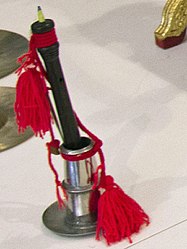music.wikisort.org - Instrument
The hne (Burmese: နှဲ; also spelled hnè) is a conical shawm of double reed used in the music of Myanmar.
 | |
| Classification | Wind instrument |
|---|---|
| Related instruments | |
| Shawm Pi (instrument) | |
Etymology
The earliest extant written occurrence of the word hne dates to 1491 AD and is likely a Middle Mon loan word, derived from sanoy.[1] This sanoy derived from Persian loan word "Shanai".
Description
The hne (Burmese: နှဲ)has a sextuple reed (called hnegan), made from the young leaf of the toddy palm, which is soaked for six months.[1] The body of the hne is made of wood, with a conical bore and seven finger holes at the front, set in a straight line, with a bell (ချူ, chu) hung at the top.[1] It has a flaring metal bell and has a loud tone, and is used in an ensemble together with xylophone, tuned gongs, and tuned drums. There are two distinct forms: the smaller form is called the hne galay (နှဲကလေး) whilst the larger is called the hne gyi (နှဲကြီး). The former is used for songs in the ordinary key of the diatonic major scale, while the latter is used for grand style songs in the subdominant mode.[2]
References
- Okell, John (1971). "The Burmese Double-Reed "Nhai"". Asian Music. University of Texas Press. 2 (1): 25–31. doi:10.2307/833810. JSTOR 833810.
- Khin Zaw (1940). "Burmese Music (A Preliminary Enquiry)". Bulletin of the School of Oriental and African Studies. School of Oriental and African Studies. 10 (3): 738. doi:10.1017/s0041977x0008873x. JSTOR 608839.
External links
See also
- Music of Myanmar
Другой контент может иметь иную лицензию. Перед использованием материалов сайта WikiSort.org внимательно изучите правила лицензирования конкретных элементов наполнения сайта.
WikiSort.org - проект по пересортировке и дополнению контента Википедии